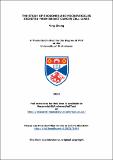The study of exosomes and microvesicles secreted from breast cancer cell lines
Abstract
Exosomes are small secreted vesicles of endocytic origin with a size range of 50-150 nm. They are secreted by many cell types and display multiple biological functions including immune-activation, immune-suppression, antigen presentation, and the shuttling of mRNA and miRNA, as well as other cargo. We have characterised the exosomes secreted from two breast cancer cell lines, MDA-MB-231 and MCF7. Exosomes secreted from both cell lines display typical markers including ALIX, Tsg101, CD9 and CD63, and were capable of inducing apoptosis of the Jurkat T cell line, indicating the potential immune-suppressive function of such tumour-derived exosomes. To further investigate the biological potential of exosomes, we loaded purified exosomes with gene specific siRNAs using electroporation, and observed the targeted inhibition of both a known component of the exosome pathway, Rab27a, and also the arthritis associated gene ERAP1, demonstrating the potential novel use of exosomes as therapeutic gene delivery vectors. We have also shown that exosomes derived from MDA-MB-231 cells and the parental cells have different lipid composition, as analysed by lipidomics study.
Nanoparticle tracking analysis (NTA), which allows the rapid detection of size and concentration of nanoparticles within the size range 10 nm-1000 nm was tested for its ability to accurately measure size and concentration of exosomes and microvesicles under different conditions. NTA was capable of detecting apoptotic vesicles induced by Taxol and Curcumin treatment. Immunodepletion was used to determine the percentage of CD9 and CD63 positive vesicles. Our data suggest that NTA is a useful technique for measuring size and concentration of exosomes and microvesicles. We hypothesized that NTA could assist in the screening of agents that interfere or promote exosome release. NTA was therefore used to detect increases in exosomes secretion induced by Tamoxifen and Thimerosal treatment, and to monitor the inhibition of exosome secretion from MDA-MB-231 breast cancer cells expressing inhibitory RNA targeted for Rab27a, a component of the exosome pathway. Increases in exosome release induced by Tamoxifen and Thimerosal was detected by NTA and a significant reduction in the release of exosomes by inhibition of Rab27a expression was also observed. Treatment with the known exosomal pathway inhibitor DMA also reduced exosome release, establishing the principle of NTA as a screening technique. We further compared the siRNA targeted cells for their ability to migrate, invade and form anchorage-independent colonies, which were all significantly reduced. Supplementation with MDA-MB-231 derived exosomes restored the ability to form colonies, suggesting exosomes may contribute to metastatic lesion formation. These data suggest that the exosomal pathway is a valid target to disrupt the behaviour of tumour cells and NTA can be used to monitor its activity.
Type
Thesis, PhD Doctor of Philosophy
Collections
Description of related resources
Rab27a and Rab27b control different steps of the exosome secretion pathwayItems in the St Andrews Research Repository are protected by copyright, with all rights reserved, unless otherwise indicated.

